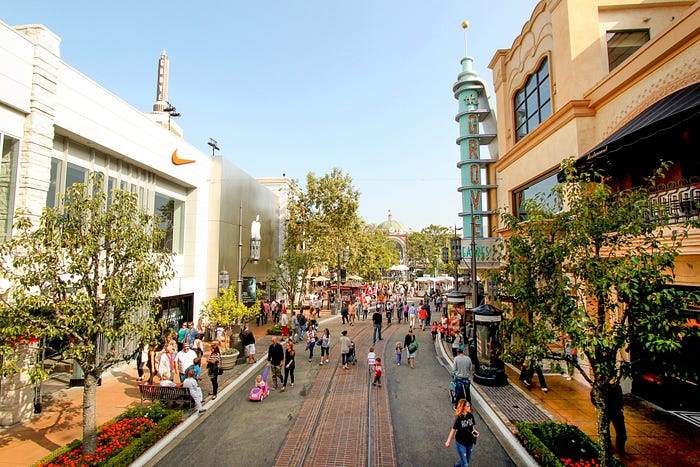We love Third St Promenade. So why don’t we have more streets like it all over Los Angeles?

In the 1950s, 3rd St in Santa Monica looked like every other street in the city; it had two lanes of vehicle traffic in each direction, and parking on both sides of the street. In other words, it looked like nearly every major street in Los Angeles.
In the 1965, the city decided to close the street to cars, and open it to people. The new “outdoor mall” was opened in November, 1965. This was not without controversy; people who fought the change, said the following:
- If you do this, you will kill the businesses on the street.
- Where will people park?
- You’re going to create traffic jams and slow down commutes.
In reality, the experiment was a huge success, and today, Third Street Promenade generates 15% of all sales tax revenue in the City of Santa Monica.
Pedestrianizing these three blocks of 3rd street were a huge success. So why hasn’t this model been replicated throughout the Los Angeles area?

In 1939, General Motors held their infamous “Futurama” exhibit at the New York World Fair. It included, among other things, a futuristic vision of cities where cars ruled the roost.
GM and other auto-centric interests also began buying up streetcar operating companies in cities like Los Angeles and deprived them of investment, which led to service decline and ultimately dismantlement.
In 1954, General Motors released a propaganda film called “Give Yourself The Green Light” that built on the momentum they started in the 30’s and pushed the car as the solution for future transportation needs. It had statements like “parking is the best investment a city can make” and reinforced the idea that cars = customers.
This momentum culminated in 1956, when the Federal Government passed the Federal Highway Act — which proceeded to build 41,000 miles of highways. In Los Angeles, the building of the 10, 101, 405, 110, 60 and 5 had a dramatic impact on the city. In Boyle Heights, the community had four separate freeways run through it, destroying two thousand homes.
The messages of GM’s Futurama exhibit and their propaganda were so effective, the arguments are still used today.
I find it odd that today, if you propose something similar to Third Street Promenade somewhere else in the LA-area, people accuse you of trying to kill small businesses, gridlock commutes, and general thoughtlessness. Yet, Santa Monica has proven that pedestrianization has the exact opposite effect.
GM did such a good job brainwashing people that many people in Los Angeles truly believe that cars shop, instead of people. They are convinced that if you remove parking or easy car access, you eliminate customers, which will hurt shops and restaurants. Ironically, some of the most popular places in Los Angeles are car-free pedestrianized areas.

The Grove, located in the middle of Los Angeles, gets an average of 49,000 visitors a day — more than Disneyland. If you look at it — it’s simply an old Los Angeles street, with a streetcar in the middle. wide sidewalks, and pedestrians everywhere.

The Americana, by the same developer as The Grove, is also an outdoor people street. The architecture of the buildings is similar to old Los Angeles, and because cars aren’t allowed, people thrive (as do the businesses).

Each week, Farmers Markets take over streets all over LA and temporarily pedestrianize them. These spaces are popular to purchase food, and they simply wouldn’t work if cars were in the mix.
Pedestrianizing streets remains a controversial topic in Los Angeles, despite data showing the huge benefits.
Pedestrianized streets:
- give people space to walk around without the threat of traffic violence
- increase foot traffic to businesses
- connect people to each other and to their communities in a way driving through the city in a car doesn’t
The most recent pedestrianizing idea is 6th St in Koreatown for a few blocks, which Streets For All is supporting. I hope it’s the first of many more across Los Angeles.